MARIANI’S
December 25, 2005
NEWSLETTER

Merry
Christmas!
UPDATE: To
go to my web site, in which I will update food
&
travel information and help link readers to other first-rate travel
& food sites, click on: home page
ACCESS TO
ARCHIVE: Readers may now access
an
Archive of all past newsletters--each annotated--dating back to July,
2003, by simply clicking on www.johnmariani.com/archive
.
NEW
FEATURE! You may now subscribe anyone you wish
to this newsletter by
clicking here.
In
This Issue
TIME TO THINK ABOUT FLORIDA?
Miami and Ft. Lauderdale by John Mariani
Dining at the Breakers by Edward A. Brivio
NEW YORK CORNER: Cookshop by John Mariani
NOTES FROM THE WINE CELLAR: 25 Italian Wines That Mattered by Mort Hochstein
QUICK BYTES
Time to Think About Florida?
by John Mariani

Curiously enough, given the trendiness of those who come to Florida to preen by the beach and wear their torn Dolce & Gabbana out to eat,
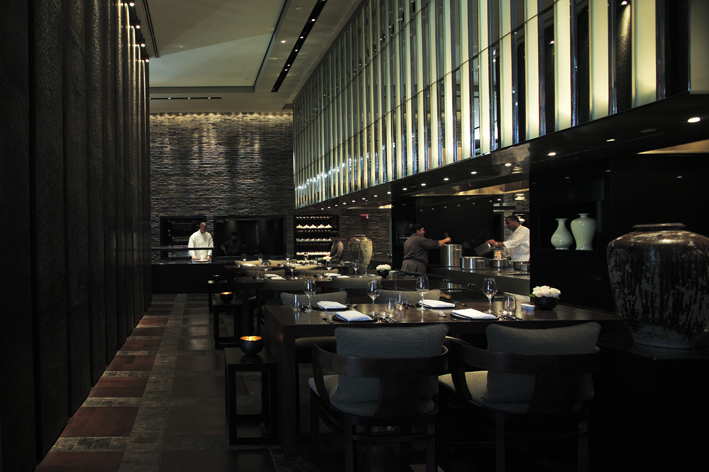 One that
most certainly has
is Setai (2001
Collins Avenue;
305-520-6000; click here),
in the art deco hotel of
the same name.
One that
most certainly has
is Setai (2001
Collins Avenue;
305-520-6000; click here),
in the art deco hotel of
the same name.The design of the lobby and restaurant, by Jean-Michel Gathay and Jaya Pratmono Ibrahim, is spread over 15,000 square feet of the ground floor, with an exquisite interplay play of chiaroscuro light and shadow, from the entrance off the lobby to the glassed-in wine room and shimmering mother-of-pearl Champagne, Crustacean and Caviar Bar, featuring as well foie gras, culatello and pata negra hams, Balik salmon, and an array of oysters. There is also a swank bar here with one of the best selections of spirits on South Beach.
The main dining room (above) is spectacular--I named it the Best New Design for 2005 in my annual Esquire round-up (click)--sleek, with hard metal and stone surfaces softened by dramatic lighting and a huge open kitchen manned by Chef Shaun Hergatt
It is not all that easy, however, to match wines to Hergatt's menu, for there are many very hot dishes here. Indeed, if you start off with his zesty, incendiary Thai salad of prawns, pink pomelo, tamarind and chili, your palate's going to be tingling for a while.
The menu is in fact a mix of traditional and novel ideas about Pan-Asian food, from salt-pressed Tasmanian ocean trout with a kalamansi dressing and nashi pear and daikon sprouts to excellent grilled sirloin of Australian wagyu-style beef. In between there is fried chicken with coriander and fennel seed doused with intensely hot chili, and sea scallops lightly cooked with vegetables fried and laced with XO sauce. Wok-seared spiny lobster with water chestnuts , ginger root and fefu noodles was delicious, and while I enjoyed the puffy Indian naan bread, with a choice of dipping sauces, twelve dollars seems a tad pricey for bread; neither was it replenished.
The restaurant offers an array of mignardises at $2 per piece (usually provided complimentary in high-end restaurants), but pâtissier Janssens offers more substantial desserts like “Sweet Crescendos” of passion fruit wontons, yogurt sorbet with cilantro, and a marvelous selection of tropical-flavored ice creams and sorbets.
Setai is clearly the big new beautiful thing on South Beach, and it's a welcome relief of beauty and refinement otherwise lacking here.
Appetizers at Setai run $18-$28, entrees $24-$38.
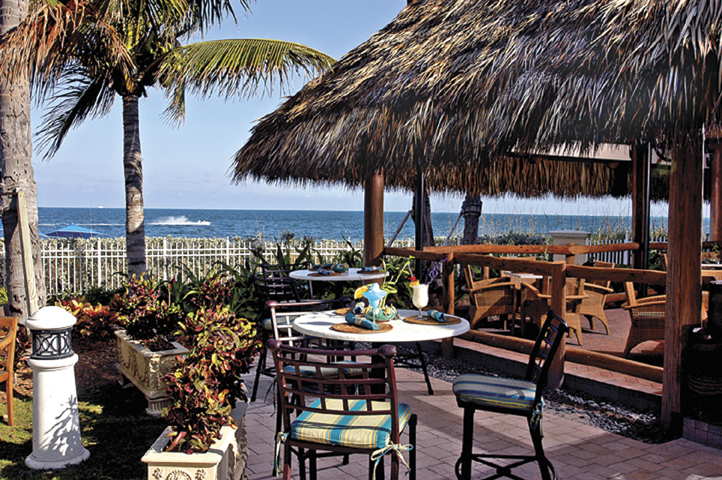 anchored by the beautiful and quite large,
rambling Ritz-Carlton Hotel (455 Grand Bay Drive; 305-365-4500; click ). It has the typical posh of
Ritz-Carlton properties with a definite nod to where it's located in
Miami, so that the formality is loosened up, the public areas very open
and airy, and the pool and patio area. Out beyond the door of the Italian restaurant Cioppino
(whose very fine chef, Carlos Sernaglia, unfortunately left last month)
and beyond the
pretty blue pool is the hotel's second restaurant, Cantina Beach (305-365-4286), where you can drop by for light fare or a
full-course meal based on the cuisine of the Mexican coastline,
via Chef
Andrés Jimenez. It's a very pretty, windblown place, with plush
chaise lounges and a Mexican thatched roof above the al fresco dining area and seems far
removed from the rest of Miami. The bar is
very popular, especially with those who need a crash course in the
myriad tastes of tequila. On hand is a tequiller (or should it be tequillero?), who is eager to
discuss the spirit's fine points over flights of young and aged
tequilas, he spirit, perhaps beginning
with a tequila blanco like Hacienda del
Cristero
anchored by the beautiful and quite large,
rambling Ritz-Carlton Hotel (455 Grand Bay Drive; 305-365-4500; click ). It has the typical posh of
Ritz-Carlton properties with a definite nod to where it's located in
Miami, so that the formality is loosened up, the public areas very open
and airy, and the pool and patio area. Out beyond the door of the Italian restaurant Cioppino
(whose very fine chef, Carlos Sernaglia, unfortunately left last month)
and beyond the
pretty blue pool is the hotel's second restaurant, Cantina Beach (305-365-4286), where you can drop by for light fare or a
full-course meal based on the cuisine of the Mexican coastline,
via Chef
Andrés Jimenez. It's a very pretty, windblown place, with plush
chaise lounges and a Mexican thatched roof above the al fresco dining area and seems far
removed from the rest of Miami. The bar is
very popular, especially with those who need a crash course in the
myriad tastes of tequila. On hand is a tequiller (or should it be tequillero?), who is eager to
discuss the spirit's fine points over flights of young and aged
tequilas, he spirit, perhaps beginning
with a tequila blanco like Hacienda del
CristeroThese go down easily, with a little fire, so soak them up with entradas like guacamole prepared tableside, or crispy rolled flautas of chicken that have been braised in achiote and topped with queso blanco. There is also an array of ceviches, from shrimp with cilantro and jalapeños to octopus with guajillo pepper-infused oil.
There's a delicious quesadilla filled with lobster and served with mango; a crispy whole red snapper served with arugula, pickled onions, cherry tomatoes and tamarind dipping sauce; enchilada verde grantinadas made with layers of corn tortillas stuffed with grilled chicken,
This is food easy to love (entrees range from $18-$28, but you could make a meal of the starters), but there are desserts here worth saving up for, including a find flan with macerated berries and coconut ice cream lollipops with a fruit compote. Cantina Beach is a very casual place and pretty wonderful when the winds sweep on through the rafters and cool things down.
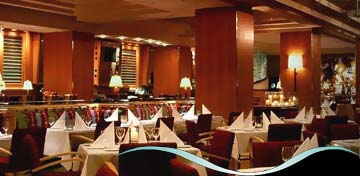 Less
than an hour's drive from Miami, the city of Fort Lauderdale is
beginning to get some very good restaurants, not least in the strip
known as Las Olas, where you'll find Mark Militello's eight-year old
Mark's Las Olas and Johnny Vincencz's two-year-old Johnny V (click). Four
years ago 3030
Ocean (3030
Less
than an hour's drive from Miami, the city of Fort Lauderdale is
beginning to get some very good restaurants, not least in the strip
known as Las Olas, where you'll find Mark Militello's eight-year old
Mark's Las Olas and Johnny Vincencz's two-year-old Johnny V (click). Four
years ago 3030
Ocean (3030
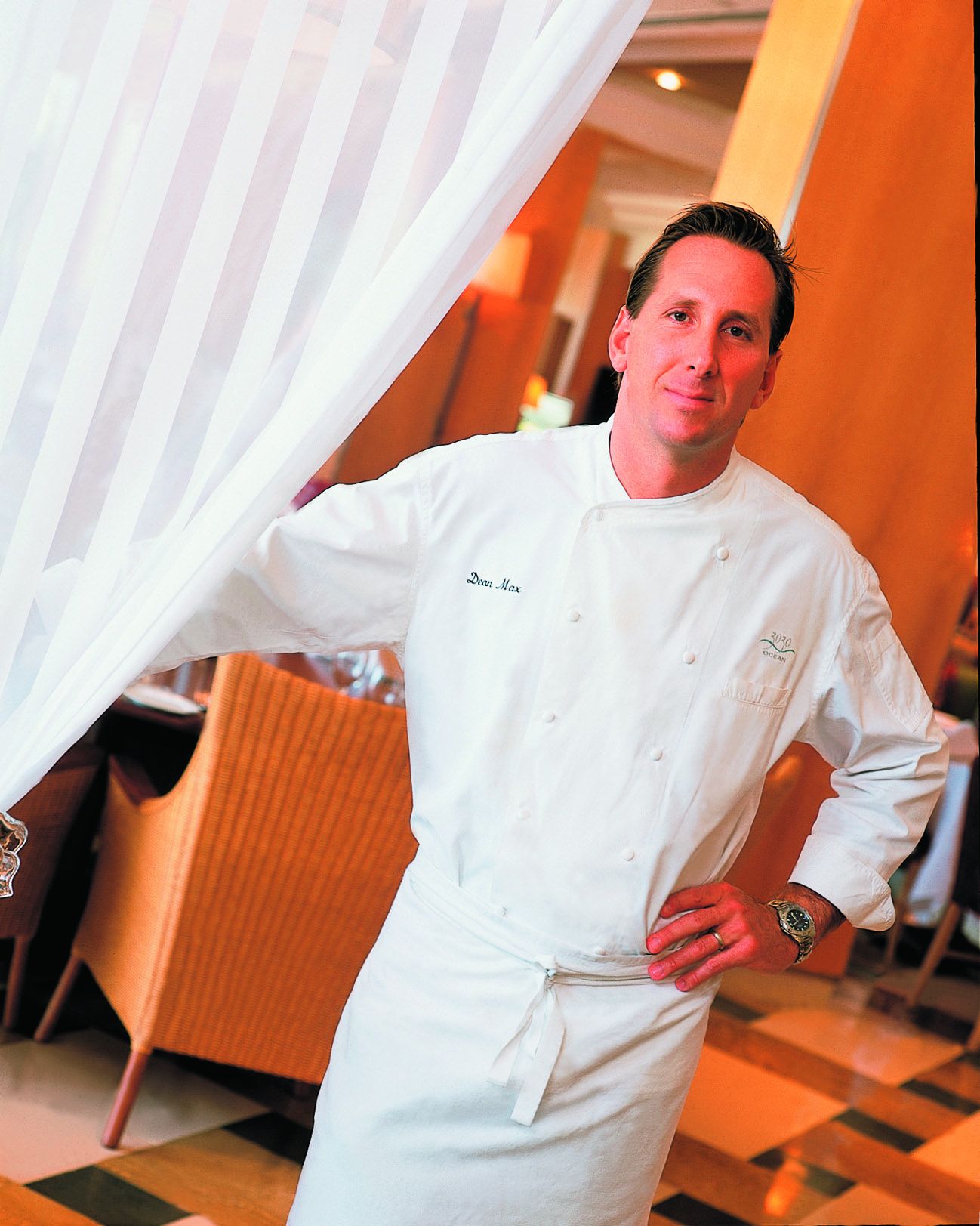
It's a very beautiful 80-seat dining room and raw bar, with strong colors of blond and painted wood, slatted shudders, shadows from candlelight and frosted glass fixtures that evoke light under the sea. The bar is a very lively spot, and there is an excellent guitarist in residence here whose music never intrudes.
My wife and I could hardly resist starting out with some jumbo stone crab claws, a crustacean I've never known to travel well outside its native state, and these at 3030 were excellent examples. Chilled jumbo Gulf white shrimp were just as tasty, and fresh as the sea was an ahi tuna ceviche sparked with a touch of serrano peppers, cilantro, green onions, and a lightly sweet coconut sauce. All these were a kind of pre-appetizer, but ones we could have feasted on for an entire meal.
Our starters included seared jumbo scallops (everything here seems to be jumbo) with a white truffle butter risotto, and I find increasingly that scallops seem to go well with creamy rice dishes, and white truffle butter doesn't hurt either. Mussels (which, thank God, we're not those awful jumbo varieties) came in a spicy ginger-lemongrass broth that was also a winning combo. Our entrees began with roasted suzuki mullaway--a species I knew nothing about, and, after some research, know little more: It may be an Australian name for a grouper in the giant sea bass family, called the jewfish (Epinephelus itajara), although that particular species does not seem to swim in western Pacific waters. Anyone with intimate knowledge of the mullaway is invited to enlighten us all on the subject. In any case, it's a nice meaty fish, and Max prepares it with a Yukon potato puree, bok choy, watermelon radish, and a black truffle sauce. We stayed closer to home with a Florida red snapper with boniato, green onions, and a lovely carrot cumin sauce.
Desserts are all made fresh and have great color and flavor, from roasted banana creme brûlée to a passion fruit tart in a macadamia nut shell. There is also a selection of artisan cheese, something you rarely find in Florida restaurant.
I'm betting that Max's reputation will grow in the near future. His talent is formidable, his taste refined, and his restaurant very beautiful.
Appetizers run $8-$14, entrees $24-$38. A 3-course fixed price menu is $37, or with wines, $50; 5-course menu, $75, with wine $100.
D ining at the Breakers
by Edward A. Brivio
Photos by Robert Pirillo
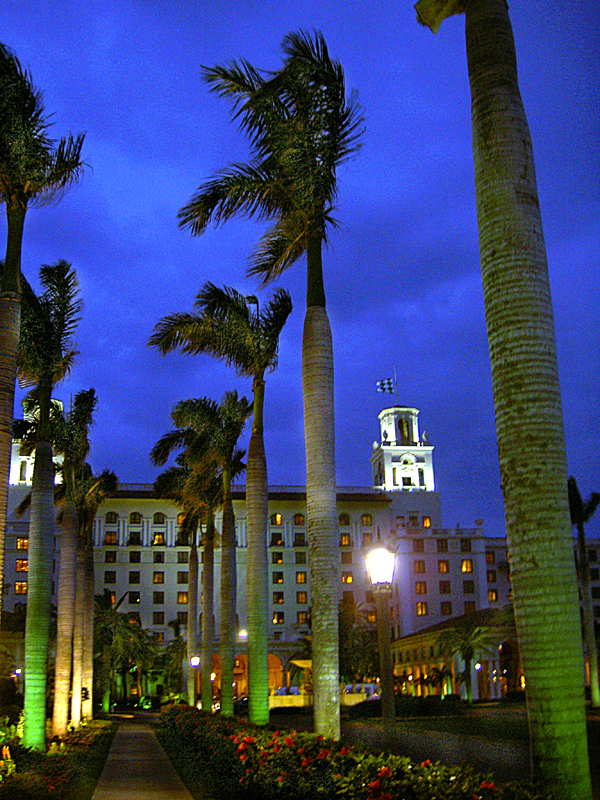 S
ome
of
the finest restaurants in Palm Beach
S
ome
of
the finest restaurants in Palm Beach The fanciest and most beautiful restaurant here is the hotel's flagship, L'Escalier (below), where French cuisine is updated and given a seasonal, local twist in a dining room done in the same ornate, and breathtaking1920's Italianate decor as the famous lobby. In this opulent Gilded Age setting, dining like one of the era's grandees on quail and foie gras, followed by
Pan-seared Hudson Valley foie gras with brioche bread pudding and a few grapes sautéed in Riesling almost made me wish it were cold outside, while a brace of honey-roasted Cavendish Farms quail served with farro and micro-greens were beautifully browned, the honey accenting the sweetness of the meat rather than turning it into dessert.
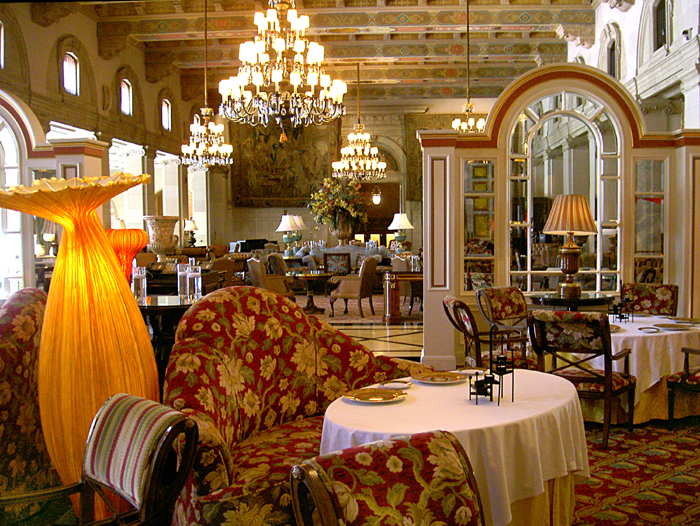
Mango and passion fruit "ravioli," actually slices of mango layered with a passion fruit curd, surrounded with a tropical fruit salsa and a scoop of coconut cream cheese sorbet was rich and satisfying yet somehow light and refreshing at the same time.
The jewel in the crown at L'Escalier is Master Sommelier Virginia Philip. Although she was absent the night we dined at L'Escalier, her shoes were ably filled by her second-in-command, Juan Gomez, who recommended a '99 Vosne-Romanée Les Petits-Monts ($95) from Alex Gambal. Only 75 cases of this wonderful red Burgundy were made, never to be confused with a fruit bomb from the New World. With dry cherry fruit, good intensity and structure, it was just the kind of little-known, hard-to-find gem that good sommeliers are aware of.
L'Escalier is a room for your best clothes, for kicking back after dinner over port (the 20 year old Fonseca tawny did quite well at $19 per glass) or cognac (the Courvoisier "Napoleon" is $23), and, if you're seated in one of the big comfortable banquettes around the periphery, for spending a leisurely evening watching the other well-dressed guests, as well as the brigade of busy chefs in the spotless kitchen.
A 3-course prix fixe dinner is $85; menus degustation run $95 & 105.
The newest on the resort's roster is the Italian Restaurant, set within its own secluded, flower-filled garden, complete with Mediterranean stone fountain and just a few steps from the main building. This is designed to be a family-friendly dining room; there's even a supervised play space for kids, close enough so you can keep an eye on them, yet far enough away to be out of earshot. The decor has the rustic, laid-back charm of a country kitchen--solid, refectory-type tables, sturdy, high-backed oak chairs rugged enough to withstand even the most rambunctious of adolescents), and a few touches of gingham, all done with great style, both fresh, and beautiful.
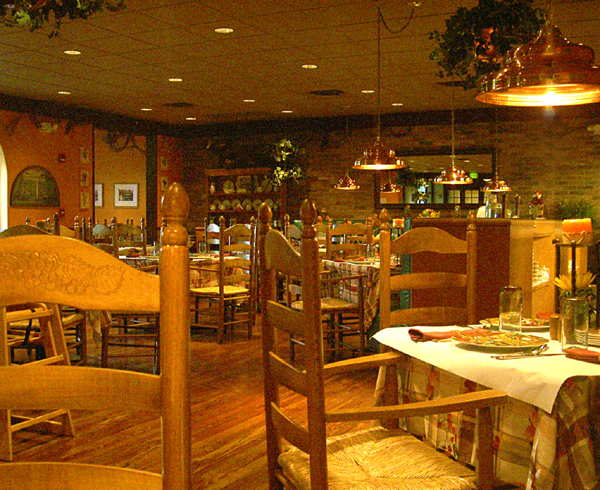 Expect Italian-American comfort food
here, although a few pared-down dishes, such as the wonderful beef
carpaccio,
are more reminiscent of true Italian cooking. “L'abbondanza” may well be
the keyword here, that hearty, full-flavored character that makes this
cuisine
so popular with kids. But the top-notch ingredients and careful
preparation
make a meal here anything but a cliché and just as satisfying
for a
demanding adult. An eager, young waitstaff doesn't hurt either.
Expect Italian-American comfort food
here, although a few pared-down dishes, such as the wonderful beef
carpaccio,
are more reminiscent of true Italian cooking. “L'abbondanza” may well be
the keyword here, that hearty, full-flavored character that makes this
cuisine
so popular with kids. But the top-notch ingredients and careful
preparation
make a meal here anything but a cliché and just as satisfying
for a
demanding adult. An eager, young waitstaff doesn't hurt either.Mussels alla
The two pastas I tried were shrimp scampi over linguine, made with fresh jumbo shrimp served in an earthenware casserole, and hearty rigatoni alla romana, with sausages, wild mushrooms, and a tomato sauce enriched with cream. For wine, we drank an altogether excellent, Marqués de Griñon Domain de Valdepusa Cabernet Sauvignon, ‘99 ($75) with its rich, ripe
Antipasti at The Italian Restaurant run from $6.50-$14.; pastas, $16.50 -$23.; main courses, $22-$36.
As if a stay at the Breakers itself weren't luxury enough, the hotel recently opened Flagler Club as a means of providing the exclusivity and personalized service of a "boutique" hotel, while still furnishing all the amenities of a larger property. The Concierge Level comprises the top two floors of the main building, accessible only to Club "members," with its own concierges, a lounge with the comfortable feel of an
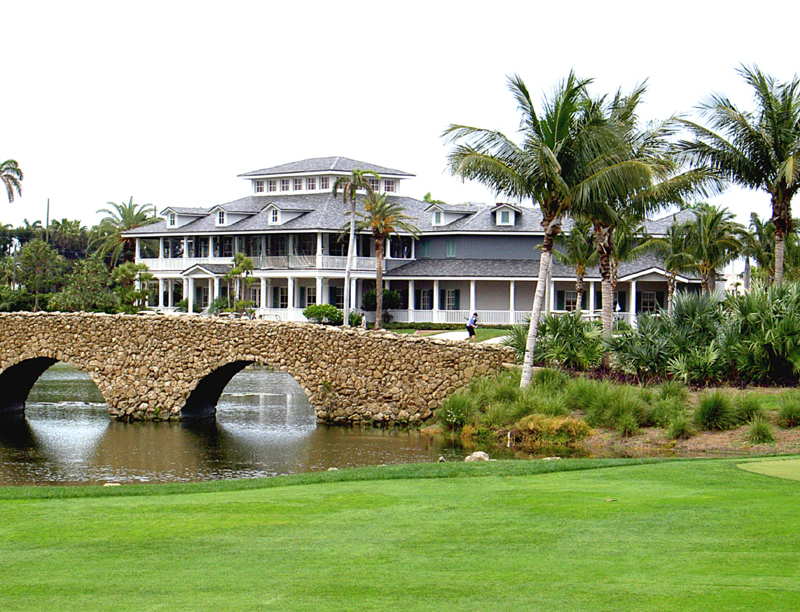
At our meal, jumbo crab cocktail was followed by a perfectly done medium-rare
Appetizers are $10-$14, main courses $32-$59.
A ll of this on a warm, balmy evening out on the wide terrace, while I watched the fairways slowly turn to shadow in the fading light, and just across the road, the room lights coming on one by one in the main building of the hotel, sitting serenely at the end of palm-lined Breakers Row. It was a
NEW YORK CORNER
COOKSHOP
156 Tenth Avenue
212-924-4440
 Sometimes you can tell
immediately that people really love being at a particular
restaurant, and for all the right reasons. While many foodies
jag from one new place to another simply to be the first to report
their reaction, then never return, more reasonable, hungry people
glom onto a new restaurant after a particularly satisfying first visit
and return because they know the food will be consistently good and in
a style and atmosphere that makes regulars of them all.
Sometimes you can tell
immediately that people really love being at a particular
restaurant, and for all the right reasons. While many foodies
jag from one new place to another simply to be the first to report
their reaction, then never return, more reasonable, hungry people
glom onto a new restaurant after a particularly satisfying first visit
and return because they know the food will be consistently good and in
a style and atmosphere that makes regulars of them all.Cookshop could float for years simply being a neighborhood favorite in Chelsea, like Black Cat, Da Umberto, and La Luncheonette have become. Chelsea restaurants, not being as trendy as those come-and-go Meat Market District eateries, have to work a little harder for patronage by serving the kind of food the locals can eat on a weekly basis. I know I could, and I don't live in the neighborhood. But I will gladly heap praise on Cookshop for anyone anywhere who wants to dine well at a reasonable price in a place where the service staff is genuinely happy to see you the first or the tenth time.
The L-shaped room can get a crush up front on a busy night (once the demanding foodies scram, it should be lighter), but the managers try hard to get you seated, which may be across from the bar (not an ideal spot, given the brush of people coming and going). Despite the current crowd and some wholly unnecessary piped-in music, the noise level is not too bad, and we were able to carry on a conversation at a tolerable level at one of the banquettes (above) to the rear. The colors--browns, taupe, reds--lighting, stained white oak, and bamboo chairs make this a casual, comfortable place to enjoy Chef de Cuisine Joel Hough's cooking, which is modern American with all sorts of international influences that do not detract from the central thesis that hearty, slow cooking is always going to please people. Too bad there are no tablecloths, which would add measurable warmth to the ambiance.
Cookshop (I can't say I love the mundane name) is owned by Marc Meyer, who's long had a success on his hands as owner of Five Points, following stints at Odeon and An American Place in NYC, and Brasserie Savoy, in San Fran, with stops along the way in Italy. The menu at Five Points isn't radically different from the kind of food Hough is doing here, and with appetizers $8-$12 and main courses $18-$25 (there is a $36 dry-aged strip steak), and a snack column of items like air-dried beef, fried spiced hominy, and shrimp beignets ($3-$6), you can get out rather cheaply if you like. Beverage director Rebecca Foster's marvelously selected wine list of good buys, especially from Spain, Argentina, Chile, and Italy, makes the wine tab very reasonable too.
The starters range from very tender grilled squid with white runner beans and an assertive salsa verde to a pretty nice pizza with grilled onions and mozzarella di bufala. If you like chicken livers, you'll love these--crispily fried, with russet-chive potatoes and hot sauce. Best of all were fresh Florida shrimp with andouille-spiked grits. The difference between fresh shrimp and frozen (99.99 percent of all the shrimp sold in the U.S.) can be astonishing.
The entrees break out into "Sauté," "Grill," "Rotissserie," and "Wood Oven," we chose among them: Chile-braised short ribs with more grits and fried onions showed clearly that Hough knows what goes best together in delicious harmony. So, too, sea scallops with a purée of celery root, sweet fried parsnips, and a ginger-tangerine brown butter worked very well, and suckling pig--a very tough thing to pull off in most restaurants--was tender, with a good piece of crisp skin, served with scarlet runner beans and a lovely roasted Winesap apple. O.K., but nothing more was a ricotta lasagna with various mushrooms and a sage-walnut pesto whose sage got in the way and dominated an otherwise pleasant dish. We ordered a side of spiced fries, nicely crisp but those spices overpowered the flavor of the potatoes.
With this course we enjoyed a superb Viña Mein barrel-fermented Ribero del Duero '04 ($54), a blend of treixadura, godello, loureira, albariño, torrontes, albilla, and caiñol grapes that came together beautifully.
Pâtissier Heather Miller does a fine job of homey but stylish desserts that included a wintry spice cake that was just perfect. Indeed, perfection within a set of its own standards is something Cookshop strives for: not to be the most creative or the most glamorous new restaurant in town but to establish itself as a place for dependable, consistent, delicious food most sensible people would want to eat again and again. I'm very glad it does what it does so well.
25 Italian Wines That Mattered
by Mort Hochstein
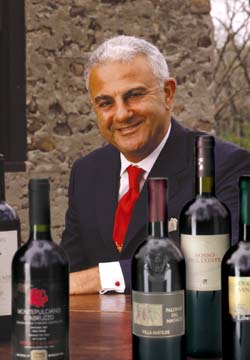
It’s 1980 and what most Americans know more about Italian wines is limited to Bolla Soave and Valpolicella, cheap Chianti in a straw flask, and maybe, just maybe, a sweet, pink, fizzy wine called Riunite Lambrusco. It was the year Leonardo LoCascio (right), a vice-president on the fast track at Citibank in
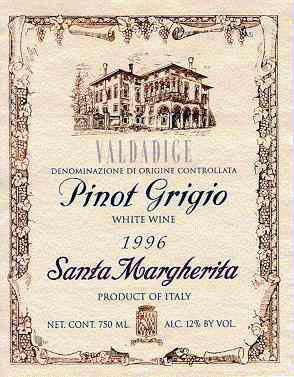 Recently LoCascio
chose what he considered the 25 most
influential wines of the last 25 years, and it's an interesting
topic for debate and further consideration. Granted, most of the 25
were from Winebow, but his first choices Riunite
Lambrusco
($4.69) and Santa Margherita Pinot Grigio ($17),
both
imported by
the competition. LoCascio contends that Riunite (which is
imported by Banfi) opened the door for other Italian
imports,
and Santa Margherita (Paterno Imports) because it introduced a
whole new category
of
white wines from the north. Others, LoCascio said, were chosen
because they
represent
the quintessential wine of a master winemaker, and others because of
exceptional quality.
Recently LoCascio
chose what he considered the 25 most
influential wines of the last 25 years, and it's an interesting
topic for debate and further consideration. Granted, most of the 25
were from Winebow, but his first choices Riunite
Lambrusco
($4.69) and Santa Margherita Pinot Grigio ($17),
both
imported by
the competition. LoCascio contends that Riunite (which is
imported by Banfi) opened the door for other Italian
imports,
and Santa Margherita (Paterno Imports) because it introduced a
whole new category
of
white wines from the north. Others, LoCascio said, were chosen
because they
represent
the quintessential wine of a master winemaker, and others because of
exceptional quality.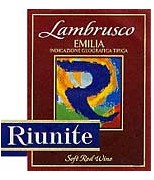
both from Bolgheri; four of Italy’s greatest wines not in the Winebow stable are on the list are Sassicaia Tenuta San Guido and Ornellaia Masseto, Antinori Tignanello, which launched the Super Tuscan category; and Gaja Barbaresco Sorí Tildin, from Piedmont, which is also represented by Coppo Barbera d’Asti, Giacosa Barbaresco Asili, and Roberto Voerzio Barolo Veccie Vita Capalot e delle Brunate.
Other Tuscan entries are Altesino Brunello Montosoli, Poggio Scalette Il Carbonaione, Tua Rita Gusto di Notri, and Poggio al Tesoro Dedicato a Walter, from LoCascio’s own vineyard.
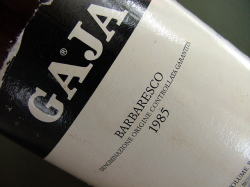 His
choices from the
His
choices from the Clearly over the last 25 years the American public has developed greater sophistication and interest that go beyond chardonnay and cabernet Sauvignon. Red grapes such as aglianico, nero d‘avola, and cannonau, and whites like vermentino, fiano and greco now appear in rising numbers as varietals or in blends in stores and on restaurant lists.
I tasted the Sardinian '00 Argiolas Turriga ($68), a dark, deep, concentrated, spicy monster, rich in ripe fruit flavor, a perfect match for Sardinia’s hearty cuisine. Equally powerful but with more elegance, the ’98 Roberto Voerzio
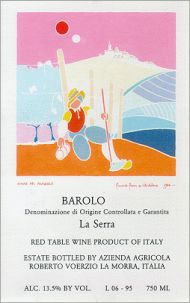 Barolo
Brunate ($150) is
a classic, its nose throwing off eucalyptus, tobacco and berry fruit,
velvety
on the palate, with a long finish. Also from the
Barolo
Brunate ($150) is
a classic, its nose throwing off eucalyptus, tobacco and berry fruit,
velvety
on the palate, with a long finish. Also from the 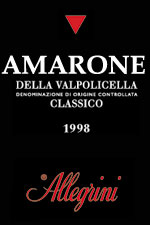 Also a product of Cotarella, the ‘03 Falesco Vitiano
($7.99),
a blend of
cabernet, merlot
and sangiovese is a fruit-forward mouthful, meant for early drinking,
Cotarella’s successful innovation has inspired other winemakers in
Lazio and
Also a product of Cotarella, the ‘03 Falesco Vitiano
($7.99),
a blend of
cabernet, merlot
and sangiovese is a fruit-forward mouthful, meant for early drinking,
Cotarella’s successful innovation has inspired other winemakers in
Lazio and The Allegrini Amarone '00 ($45) represents a new style, a food-friendly wine, succulent and generous on the palate, sweeter and much more approachable than the dull and often oxidized traditional version it has supplanted. The desert-like climate of Basilicata is not a likely place to find fine white wines, but the ’04 Cantina di Venosa Dry Muscat challenges that assumption. It is sweet but not cloying, delicate but far from fragile, and a delightful way to start an afternoon or end a dinner.
The prices above reflect an average of retail prices from www.wine-searcher.com.
WHAT IF YOU'RE BLOND, NOT PRETTY, BUT KIND OF INTERESTING?


NEXT MONTH. . . SARDINE CRÈME CARAMEL!
Jones Soda of Seattle has come up with a salmon-flavored soda pop.
QUICK BYTES
* Boston’s
* From Jan.20-22 Mohegan Sun’s Third Annual Sun WineFest, in Uncasville, CT, is once again hosting a weekend of cuisine from celebrity chefs, cooking demonstrations and competitions and a Grand Tasting of more than 1,000 exhibitors. Also, “Celebrity Chef Press Meet and Greet,” with chefs Luis Bollo, Jimmy Burke, Todd English, Michael Ginor, Mary Ann Esposito, Chris Schlesinger,
MARIANI'S VIRTUAL GOURMET NEWSLETTER is published weekly. Editor/Publisher:
John Mariani. Contributing Writers: Robert Mariani, Naomi
Kooker, Kirsten Skogerson, Edward Brivio, Mort
Hochstein, Lucy Gordan, Suzanne Wright. Contributing
Photographers: Galina Stepanoff-Dargery, Bobby Pirillo. Technical
Advisor: Gerry McLoughlin.
Any of John Mariani's books below
may be ordered from amazon.com by clicking on the cover image.
 |
 |
 |
 |
 |
 |
copyright John Mariani 2005